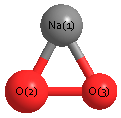Vibrational Frequencies calculated at B2PLYP=FULL/cc-pVTZ
| Mode Number |
Symmetry |
Frequency
(cm-1) |
Scaled Frequency
(cm-1) |
IR Intensities
(km mol-1) |
Raman Act
(Å4/u) |
Dep P |
Dep U |
|---|
| 1 |
A1 |
1094 |
1045 |
0.38 |
9.99 |
0.25 |
0.40 |
| 2 |
A1 |
422 |
403 |
45.75 |
4.78 |
0.09 |
0.17 |
| 3 |
B2 |
361 |
345 |
3.84 |
3.98 |
0.75 |
0.86 |
Unscaled Zero Point Vibrational Energy (zpe) 938.1 cm
-1
Scaled (by 0.9558) Zero Point Vibrational Energy (zpe) 896.7 cm
-1
See section
III.C.1 List or set vibrational scaling factors
to change the scale factors used here.
See section
III.C.2
Calculate a vibrational scaling factor for a given set of molecules
to determine the least squares best scaling factor.
